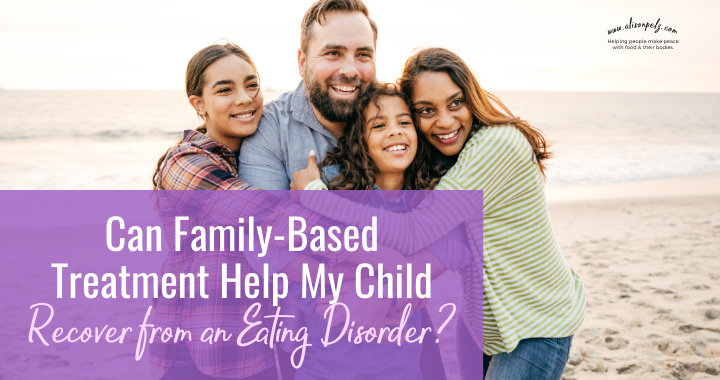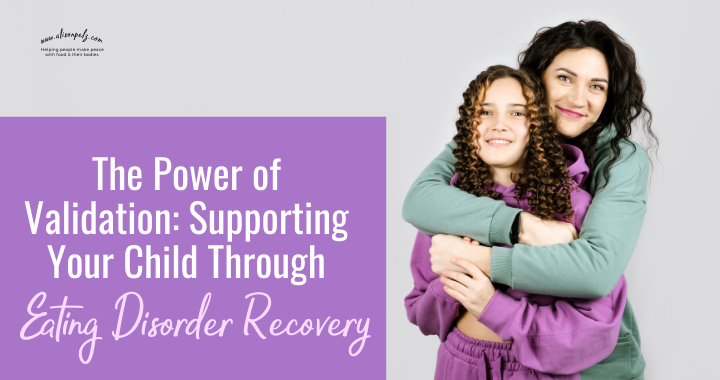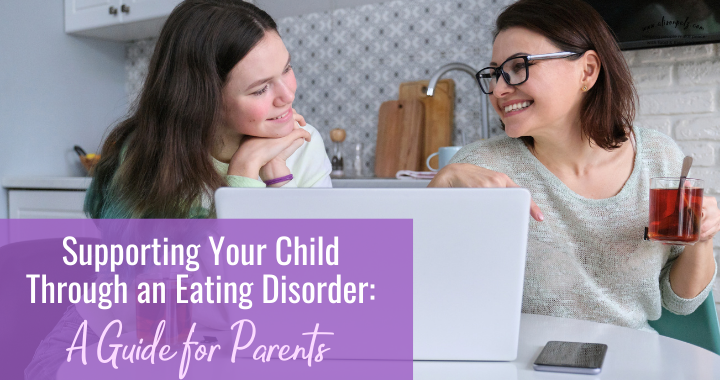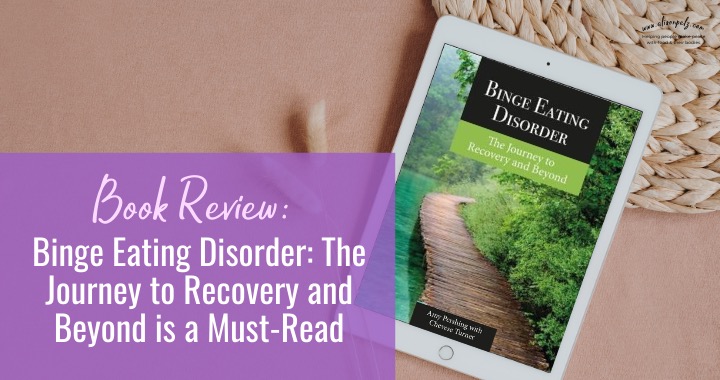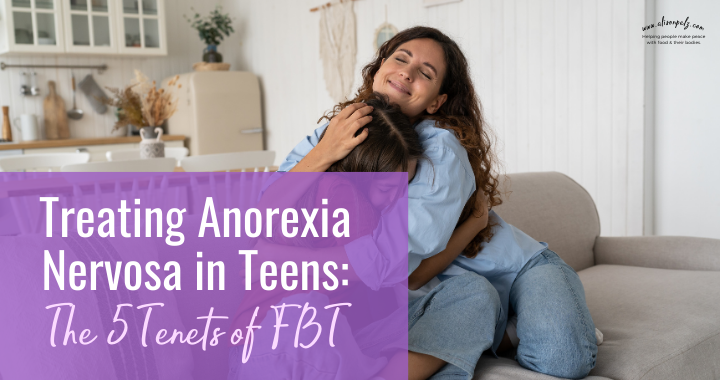If you are a parent or caregiver, desperate to help your child who is struggling with an eating disorder, family-based treatment may be the solution you are searching for.
Often, families come into my office worried sick about their child.
Their child might have lost a lot of weight or been acting “sneaky” around food. Maybe their child has been over-exercising, using laxatives, or throwing up after eating.
Or, they might be worried because their child only eats a small number of foods, or eats a lot of food at once.
Or maybe your child has become an extremely “picky eater”.
On top of that, parents are often terrified because they have heard doctors mention hospitalization and many therapists have turned them away. When they do research online, things look bleak.
No matter their child’s symptoms, when families first come in they are often frantic, frustrated, and feeling powerless. They don’t know what to do.
If you find yourself in a similar boat today, you’re not alone. I have worked with countless families who walk into my office feeling this way. Sadly, there’s a lot of blame put on the parents. All they want for their child is to get better and live a happy life without the constant obsession with food.
Many parents have been seeking help for a while. Unfortunately, they have found no real results. They often receive criticism, but no real guidance on how to help their child get better, or well-meaning doctors say they will grow out of it and that it’s just a phase.
I’m here to give you hope.
After years as a therapist and registered dietitian, I’ve seen the positive results that come from family-based treatment where parents are properly equipped and supported to be part of the solution their child needs.
Why Choose Family-Based Treatment?
Family-based treatment (FBT) for eating disorders is an evidence-based treatment for disorders like anorexia, bulimia, binge eating disorder, and even ARFID (i.e. extreme selective eating).
Unlike many other treatments that put the responsibility on the identified patient or the person with the eating disorder, FBT includes the parents. Instead of seeing the parents as part of the cause of the eating disorder, they are seen as part of the solution.
We use your expert knowledge of your child to help your child get better.
This method of treatment makes sense to parents. If your child had cancer or some other serious medical condition, you, as the parents, would be highly involved in treatments including appointments, physical therapy, and all the steps to recovery.
It shouldn’t be any different for treating eating disorders.
Eating disorders are an epidemic in our country. According to the NIH, for teens between the ages of 13 and 18, the lifetime occurrence of anorexia, bulimia, and binge eating disorder is 2.7%. These disorders are twice as common among girls than boys. They also tend to be more common the older the teen gets.
When it comes to ARFID or avoidant/restrictive food intake disorder, the prevalence is between 5 and 22%, with about 2% reaching the need for help. ARFID also tends to happen with anxiety disorders and neurodivergence. Effective, evidence-based treatment for eating disorders is important and necessary.
How Effective is Family-Based Treatment?
Family-based treatment has been used in the United Kingdom for many years. It has proven to be more effective than other forms of eating disorder treatment.
With a 75% success rate, teens receiving FBT also recover faster than with other treatments. The research also shows that teens are doing better after engaging in FBT than in other treatments.
How Does Family-Based Treatment Work?
In family-based treatment, a clinician guides the parents in empathizing with the child while also holding boundaries around eating, food, and other eating disorder behaviors like binge eating and laxative use.
The therapist coaches the parent on how to teach their child to eat again. The goal is for the child to eventually have age-appropriate responsibility with food intake and eating habits, once the child has reduced their eating disorder symptoms and is stabilized. They also want to encourage an appropriate relationship with food and their body image.
Family-based treatment usually lasts around 20 sessions and happens in three stages.
During the first stage, the parents are responsible for preparing and serving food as well as insisting that it gets eaten. They are pretty much doing what a nurse during inpatient treatment would do. There is no room for negotiation around food or other eating disorder behaviors like purging, misusing exercise, or laxatives.
The second and third phases include slowly giving responsibility for food and exercise back to the child.
During the second phase, the child may return to more normal activities while being supervised by their parents for any signs of relapse.
During the third stage, the child begins to transition back on track with their developmental stage of eating.
What Makes FBT Different?
Family-based treatment is quite different from the standard eating disorder treatment.
First of all, at its core, FBT does not blame the child’s parents (or the child) for the eating disorder. One of the core beliefs of family-based treatment is that no one in the family is to blame. Really, the focus is on getting the child well instead of placing blame.
In other treatments, the person with the eating disorder is treated on their own outside of the family system, but with FBT, the parents, child, and sometimes even the siblings, are involved in treatment.
The parents’ care and motivation to help their child are used to make some major changes in the family’s life, especially around food. Their unique expertise on their child is used to help them get better, and parents are taught how to interact with their child around food, and other eating disorder behaviors.
This allows the family to overcome the eating disorder, together.
Another difference with FBT is the focus on food, nutrition, and eating disorder behavior rehabilitation. FBT believes that a lot of the symptoms of the eating disorder will disappear when the child is better nourished and no longer using other eating disorder behaviors. So they first focus on nutrition, feeding, and decreasing the other eating disorder behaviors.
Often, parents think that their child has to be “motivated” for treatment to be effective. One of the differences with FBT is that the child does not need to be motivated to change to get better. The motivation to make change happen starts with the parents.
What are the Benefits of Family-Based Treatment?
Family-based treatment has benefits for both the family as a whole and the child, including:
- The child or teen usually gets better faster than any other treatment, making it one of the quickest ways to help your child and family heal.
- Parents are involved in the child’s treatment, allowing them to be the child’s primary support instead of feeling powerless and at fault.
- This is a good replacement for inpatient treatment or partial hospitalization, allowing your child to stay home.
- FBT is an evidence-based approach, so you know you are doing the best you can for your child.
Now that you know how FBT can help, let’s look at who it can help.
Who is FBT for?
FBT has been shown to be effective for kids, teens, and young adults. showing signs of eating disorders.
It has been used to help kids and teens who are struggling with anorexia, bulimia, binge eating disorder, as well as avoidant restrictive food intake disorder (ARFID).
In the cases of binge eating disorder and bulimia, the family is taught to help feed their child adequately and supportively interrupt binge eating, purging, laxative use, and misuse of exercise.
FBT works both for teens who have been to inpatient multiple times and still struggle to let go of the symptoms, and for teens who have just started to engage in eating disorder behaviors, and any child in between.
FBT is not just for teens, however. It can also be used with children and young adults still living at home. FBT can be used in all different types of families or caregiving situations (like grandparent caregivers and single-parent households).
Who Should Not Do FBT?
FBT is often used instead of hospitalization. If the child is underweight and does not have any other reason to be medically supervised, FBT can be a great option rather than hospitalization.
However, if your child or teen needs to be medically supervised for another reason, then hospitalization is recommended.
In the same way, if the child needs to be supervised for other psychiatric illnesses, then this is also a situation where FBT is not going to help until the child is stable psychologically. Family-based treatment may also not be a good option if the child has experienced certain types of trauma.
What Happens During Family-Based Treatment?
Family-based treatment may last around 20 sessions. At each session, you can expect your child or teen to check in with the therapist for mental health support.
After this, the therapist will meet with the parents and child for coaching around nutrition and other eating disorder behaviors. The coaching isn’t just about what to eat but also about how to talk to your child about eating and other eating disorder behaviors, including how to express empathy without giving in.
Unlike other eating disorder treatments where the therapist just meets with the child, most of the time, the FBT therapist meets with the caregivers and child.
Family-Based Treatment is Worth the Hard Work
Family-based treatment can be very intense for the whole family. In the beginning, you will be very involved in your child’s day-to-day life, as well as your child’s nutritional rehab, but the hard work will be worth it when your child learns to eat and regains their health again.
Not only does family-based treatment help your child stay home, as hospitalizations can last weeks or months, but it also helps to heal your whole family from the disruption that the eating disorder has caused.
While it can be hard to find family-based treatment, don’t give up! Finding someone who is trained to do family-based treatment can make the difference for your child.
At the minimum, when you are seeking FBT you will need to at least start with a medical doctor and a therapist. If your team includes a dietitian, initially they will only meet with the parents and not the child.
